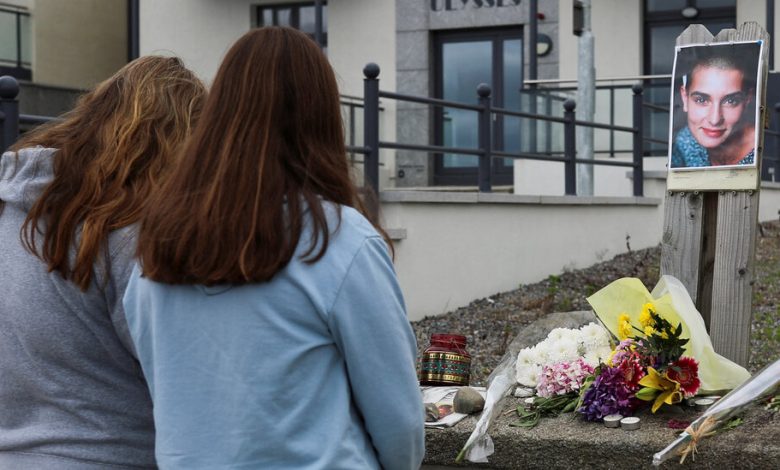O’Connor Was a Lonely Voice for Change — Until Ireland Changed With Her

When Sinead O’Connor tore up a photo of Pope John Paul II on “Saturday Night Live” in 1992, her protest caused an even bigger uproar in her native Ireland than in the United States. Thirteen years earlier, more than a million people — roughly a third of Ireland’s population — had gathered in Dublin to hear that same pope celebrate mass.
Yet by the time of her death this week at 56 years old, Ms. O’Connor’s brash acts and forthright statements no longer rattled many of her fellow citizens. Her fiery arc as a performer and public figure coincided with Ireland’s social and cultural transformation, leaving Ms. O’Connor more in sync with the more diverse, tolerant, and secular society her country has become.
Whether it was campaigning for abused women and children; gay, lesbian and transgender people; AIDS patients, racial minorities, refugees, or Palestinians, Ms. O’Connor never relented. And her journey as an activist and a musician was inextricably entwined with that of modern Ireland.
“She was still on the edge,” said Mary McAuliffe, a social historian and director of gender studies at University College Dublin. “But much of Ireland moved over, and joined her.”
The outpouring of grief and love for Ms. O’Connor, Dr. McAuliffe said, was recognition for her courage in going up against “the bastions of the state and conservatism that some people thought might never fall.”
The Ireland of 1992, during the early days of Ms. O’Connor’s stardom, was still dominated by the social and sexual doctrines of the Roman Catholic Church. Abortion was banned in almost all cases, divorce was illegal, and women and girls who became pregnant out of marriage could still be whisked away by their families to give birth in secret to hide their “shame.”
When Ms. O’Connor, who was raised Catholic, started speaking out against the church and other authorities, she was often dismissed, particularly by conservatives, including many men, as a volatile and ill-informed attention seeker.
Since then, Ireland has largely turned away from the strict teachings of the church, which has been discredited by revelations of widespread clerical sexual abuse of children, among other scandals. The Irish have voted to legalize abortion, divorce and same-sex marriage, each time in a landslide. And Ms. O’Connor, once shunned by some as an outcast and caricatured by others crazy, is now being mourned as a national treasure and a serious social critic.
“She had a standing as a person you couldn’t ignore,” said Daniel Mulhall, a former Irish ambassador to the United States. “She is of a generation that went through that process, and she was an unusual personage in that generation.”
Ireland’s transformation, Mr. Mulhall said, was propelled by more than any single agent, even one as outspoken and memorable as Ms. O’Connor. Education, economic development and membership in the European Union all played a part — in addition to the church’s decline, which Mr. Mulhall said was swifter and more complete than in virtually any Western country.
But historians said Ms. O’Connor’s early stands against the abuses in the church and the mistreatment of women, children and other vulnerable people would earn her a place in the record of the country’s transformation. “She will surely be remembered in the history books of her time, social and political, when they are written,” Professor McAuliffe said.
She came to prominence in the 1980s, when there were “a lot of silences, and a lot of secrets, for the powerful, the church and the institutions,” said Sinéad Gleeson, a writer and commentator on culture and politics.
“Sinead came along and was saying the unsayable about abortion rights and AIDS and racism and institutional abuse,” Ms. Gleeson said. “She provoked a lot of fury and ridicule because a lot of people didn’t want her telling the truth about these things.”
Ms. O’Connor also never ceased pushing the boundaries. In 1999, after making waves by defying the church, she provoked criticism and ridicule — from some progressives, as well as social and religious conservatives — when she had herself ordained as a priest by an “independent bishop” linked to a branch of the Latin Tridentine Church, a small breakaway sect of Catholicism. Catholic doctrine forbids women from becoming priests.
Yet by 2018, when Ms. O’Connor converted to Islam and changed her name to Shuhada Sadaqat, the response was more muted.
“I think it’s to do with the fact that a lot of people recognize that she was right” in many of her views before they were popular, Ms. Gleeson said. “That’s why many people are so accepting of Sinead, because she did something nobody else had the guts to do. They said, that’s Sinead. She can do what she wants.”
If, at first, some people accused her of adopting causes to bolster her ego or popularity, not unlike some other rock stars, O’Connor’s lifelong commitment to speaking for justice, and the toll it took on her, commercially and personally, showed otherwise. Her mental health suffered at times, but she made that a cause, too — speaking up about trauma, long a taboo subject, as a way of freeing others to do so.
Ireland’s head of state, President Michael D. Higgins, led the tributes to O’Connor on the evening that she died.
“To those of us who had the privilege of knowing her, one couldn’t but always be struck by the depth of her fearless commitment to the important issues which she brought to public attention, no matter how uncomfortable those truths may have been,” he said in an official statement. “May her spirit find the peace she sought in so many different ways.”
CMAT, a young Irish musician who is herself becoming widely known for her wit and nonconformity, said that Ms. O’Connor had been a major part of her life as a female singer-songwriter.
“Sinead will forever be a figure of womanly defiance, for a country that never liked women,” she said. “I think the reason that Ireland has come to a standstill over her death is because we are grieving for the life she deserved to have — one free of the punishment, mockery and torment she suffered at the hands of the public for speaking out, consistently, against abuses of power.”
Fintan O’Toole, an Irish Times columnist and one of Ireland’s leading cultural critics, said that O’Connor had exposed, and even embodied, the pain of women in a misogynistic society.
“But she did that not through self-pity but with defiance, humor, beauty and brilliance,” he said in an email. “She turned her fragility into a form of strength. She will be terribly missed.”
Mark Landler contributed reporting from London.



